Our galaxy is immense, and the solar system, which is just a tiny portion of it, still holds many mysteries. Despite years of research, we have only scratched the surface in understanding the planets that comprise our planetary system. However, advancements in technology have allowed us to gather more information about celestial bodies that are situated far away from our planet and the Sun.

The arrangement of the planets in the solar system
There is often confusion regarding the number of planets in the solar system. This confusion stems from the reclassification of Pluto. While many astronomy enthusiasts still consider it a planet, scientists argue against this classification. Here, we will discuss the planets in their proper order, starting from the one closest to the Sun.
Interesting fact: the true color of the Moon
The planets in our solar system were named after the gods and goddesses of ancient Greece and Rome.
Mercury is the first planet from the Sun
Mercury is a member of the Earth group and is the smallest and fastest celestial body among the terrestrial planets. Its revolution period around the Sun is 88 days. Mercury completes only 1.5 rotations around its axis.
For a long time, scientists believed that Mercury always had one side facing the Sun. However, advancements in technology have debunked this myth. Mercury has one of the most unstable orbits, as its speed, distance from the Sun, and position constantly change.
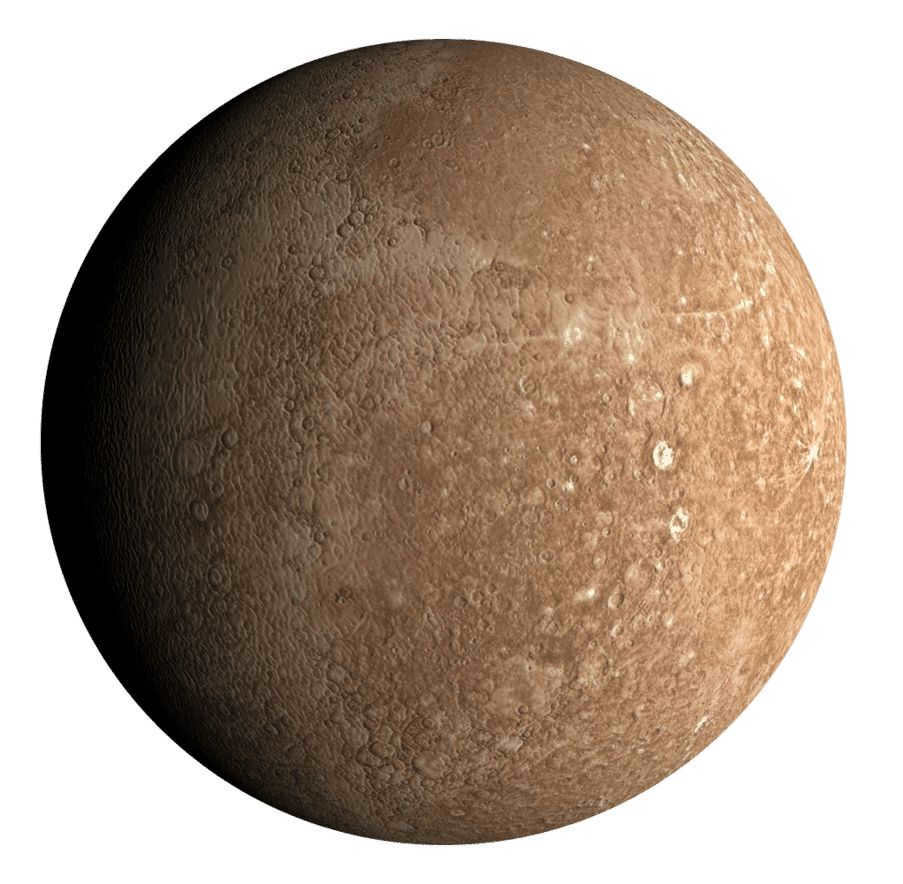

One distinctive characteristic of Mercury is its most pronounced temperature fluctuations compared to all the other planets in the solar system. This is attributed to its close proximity to the Sun. The average daytime temperature reaches approximately +350 ºC, whereas during the night it plummets to -170 ºC. The subsequent chemical elements have been detected in the atmosphere of Mercury:
Mercury does not possess any natural satellites. There exists a hypothesis that it previously orbited Venus, but this supposition lacks scientific evidence.
Venus, the second planet from the Sun, is often referred to as the morning and evening star by astronomers.
This nickname comes from the fact that Venus can be seen shortly before sunrise, when other celestial bodies are no longer visible, and it remains visible after sunset, when other cosmic objects have yet to become visible. In terms of size, Venus is similar to Earth.
The atmosphere of Venus is composed mainly of carbon dioxide, with nitrogen coming in second. There are also trace amounts of water vapor and oxygen. Due to this atmospheric composition, the surface of the planet experiences a greenhouse effect, resulting in significantly higher temperatures compared to Mercury, reaching up to +475°C. Venus is known for its slow rotation, with a day lasting 243 Earth days, almost equivalent to its year, which is 225 Earth days. Additionally, Venus does not have any natural satellites.
Venusian clouds reflect the sun’s rays in a way that makes it appear brighter than other planets in the Earth’s sky. This is why scientists named the second planet after the goddess of love and beauty.
Earth: The Third Planet from the Sun
Earth is the only celestial body in the solar system with 70% of its surface covered in water. The remaining portion is made up of continents. The Earth also has unique tectonic plates located within its mantle, which can move and result in changes to the landscape. Additionally, the Earth’s axis is tilted in relation to the ecliptic plane, which creates distinct seasons on the planet.
A day on Earth lasts for 23 hours, 56 minutes, and 4 seconds, while it takes 365 days, 5 hours, 48 minutes, and 46 seconds for the Earth to complete one orbit around the Sun.
Thanks to a multitude of studies and space imagery, scientists have been able to provide a comprehensive depiction of the Earth’s appearance. Our planet possesses a solitary natural satellite, the Moon, which exerts an influence on the tides.
Notably, the Earth and Moon exhibit a synchronized rotation, resulting in the satellite constantly presenting one side towards the planet. This makes it the sole celestial body within the Earth’s group that isn’t affiliated with an ancient Roman deity. In Latin translation, its name signifies “dry land” or “soil”. The Earth stands as a planet boasting exceptional conditions that have fostered the emergence of life.
Mars, the fourth planet from the Sun, has a unique feature
Mars stands out due to its rarefied atmosphere. Since the 1960s, extensive research has been conducted on this planet. The findings have been fascinating: evidence of water has been discovered in certain regions, leading scientists to speculate about the possibility of primitive life forms on Mars, either in the past or present.
One striking characteristic of Mars is its vibrant color, making it visible to the naked eye. Every 15 to 47 years, Mars surpasses the brightness of larger planets like Jupiter and Venus. The planet derives its name from its distinctive red surface. Unfortunately, Mars lacks a magnetic field to shield itself from the solar wind, resulting in the gradual loss of its atmosphere.
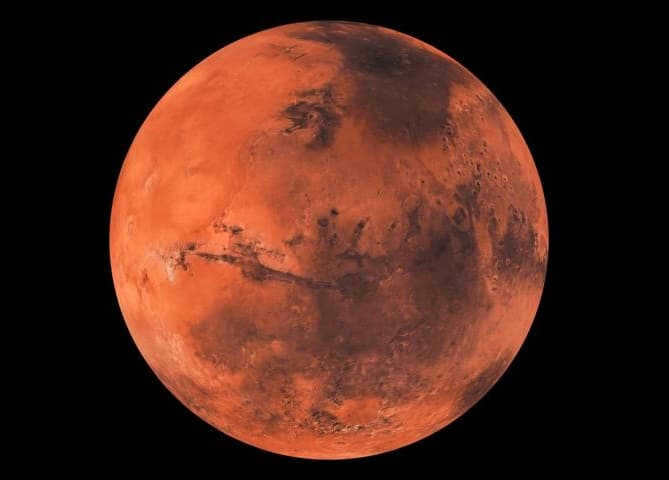
Dust storms and whirlwinds are constantly raging on the planet. Mars is known for its frigid temperatures, with daytime averages not exceeding -5 ºC and nighttime temperatures dropping to -87 ºC. The planet is orbited by two moons, Deimos and Phobos.
Scientists view Mars as a promising destination for exploration due to its optimal weather conditions for human habitation. However, terraforming Mars presents various challenges, such as:
Mars is home to Mount Olympus, the tallest volcano in the entire solar system, standing at a staggering height of 27 kilometers, three times taller than Earth’s Mount Everest.
A photograph captured by the Perseverance rover on Mars showcases the Ingenuity helicopter scaling a height of 10 meters before traversing a distance of 129 meters.
Jupiter, the fifth planet from the Sun
Jupiter, classified as a gas giant, holds the distinction of being the largest planet in our solar system. Its immense size led to its name being derived from an ancient Roman god. Jupiter’s dimensions are a staggering 318 times that of Earth. The planet’s atmosphere primarily consists of 75% hydrogen and 24% helium. Scientists theorize that beneath its gaseous exterior lies a rocky core submerged within a sea of liquid metallic hydrogen. The inability to land any equipment on Jupiter’s surface makes gathering more precise information challenging.
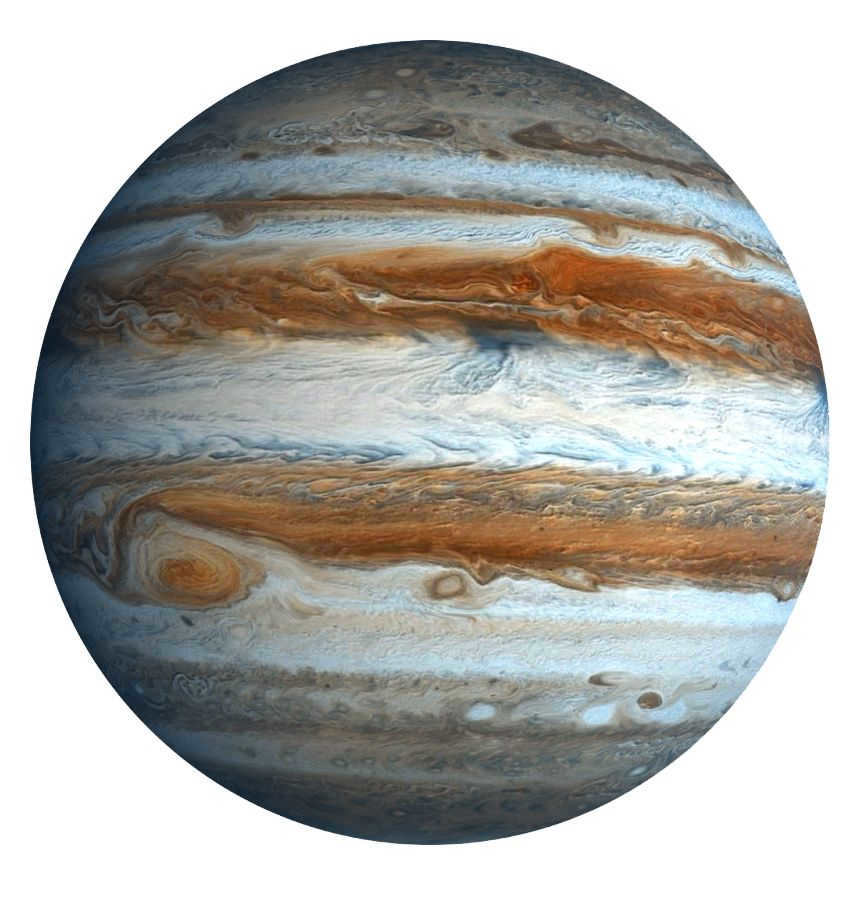
Jupiter, the fifth planet from the Sun, is characterized by strong winds blowing at a speed of 160 meters per second and the presence of ammonia clouds in its upper atmosphere. In 1664, astronomers made the remarkable discovery of the Great Red Spot, which was later identified as a massive storm. Additionally, scientists have observed lightning bolts of immense power on Jupiter. This gas giant can be considered as a miniature solar system due to its 79 satellites orbiting around it. Some of the most well-known satellites include:
One intriguing phenomenon associated with Jupiter is the significant increase in temperature in areas where the shadows of its satellites fall, contrary to the expected temperature decrease. This interesting finding was made in the 1960s through radio measurements.
A captivating image captured by NASA’s Juno spacecraft reveals a multitude of storms scattered across the surface of Jupiter.
Saturn: The Sixth Planet from the Sun
Saturn, the second largest planet in our solar system, is known for its unique geometric compression of its radius. It is worth noting that Saturn was the last planet visible to ancient scientists without the aid of a telescope. Its atmosphere is composed of 96% hydrogen and 3% helium, making it a fascinating celestial body.

Saturn, the sixth planet in the solar system, falls under the category of gas giants, making it difficult for scientists to conduct detailed studies on it. The current hypothesis suggests that Saturn possesses a rocky core which is surrounded by liquid metallic hydrogen. This core is extremely hot, with a temperature of 11700 degrees Celsius, and generates more heat for the planet than the Sun itself. The upper atmosphere of Saturn maintains a chilly temperature of -180 degrees Celsius.
Powerful winds with speeds of 500 meters per second whip across the surface of Saturn. These winds, combined with the radiant heat emitted by the core, create stunning streaks of yellow and golden hues that are visible within the planet’s atmosphere.
Aside from its magnitude, Saturn is renowned for its prominent ring system. As of 2019, astronomers have identified 82 satellites orbiting the planet, with Titan being the largest among them. Notably, the surface of Titan features rivers and lakes, although their composition primarily consists of methane and ethane. Another intriguing moon to investigate is Enceladus, where scientists have uncovered geysers comprising 93% water.
The discovery of Uranus occurred in the year 1781. This celestial body is located at a significant distance from our Sun, resulting in a Uranian year lasting approximately 84 Earth years. Among the gas giants, Uranus holds the distinction of being the smallest in size. One of the most intriguing aspects of this planet is its peculiar tilt of 97 degrees, giving the illusion that it is rotating on its side, a phenomenon that has intrigued astronomers.

The blue-green color of Uranus’ surface is a result of the presence of methane. Scientists believe that the planet has a solid core surrounded by a layer of water, ammonia, and methane ice. Unlike other planets, Uranus does not generate much heat and can have a surface temperature as low as -224°C, making it the coldest planet in our solar system.
Recent observations have revealed that Uranus has 13 rings and 27 moons, with the largest moon being named Titania.
This stunning image of Uranus was captured by Erich Karkoschka using NASA’s Hubble Space Telescope’s infrared camera and multi-object spectrometer on August 8, 1998.
Neptune: The Eighth Planet from the Sun
Neptune, which is named after the ancient Roman god of the seas and oceans, is positioned so far away from the Sun that it takes a whopping 165 Earth years for it to complete one orbit around it. Due to its remote location, Neptune cannot be observed without the aid of a telescope.
Similar to Uranus, Neptune falls into a unique category of gas giants known as ice giants. It is primarily composed of a significant amount of ice. Notably, storm activity is more pronounced at the poles of Neptune, resulting in the formation of dark spots. Wind speeds can reach up to an astonishing 600 meters per second, and temperatures can drop as low as -220°C, which is only slightly higher than that of Uranus.
Neptune boasts a total of 5 rings and 14 satellites, with Triton being the largest among them. Triton is the sole satellite of Neptune that possesses a spherical shape.
Due to its considerable distance from the Sun, only 1% of light manages to reach the surface of Neptune, in stark contrast to Earth.
Fascinating fact: Researchers theorize that diamonds could be falling as rain on Uranus and Neptune.
Comparison chart of planets in our solar system
| Name of planet | Approximate diameter (in thousands of kilometers) | Distance from Sun (in astronomical units) | Length of day (in Earth days) | Orbital period | Number of moons |
| Mercury | 4.87 | 0.39 | 59 | 88 days | none |
| Venus | 12.1 | 0.72 | 243 | 225 days | no |
| Earth | 12.76 | 1 | 24 hours | 365 days | 1 |
| Mars | 6.78 | 1.52 | 24 hours 37 minutes | 687 days | 2 |
| Jupiter | 139.82 | 5.2 | 9 hours 56 minutes | 11.86 years | 79 |
| Saturn | 116.46 | 9.57 | 10 hours 42 minutes | 29.46 years | 82 |
| Uranus | 50.72 | 19.2 | 17 hours 14 minutes | 84.04 years | 27 |
| Neptune | 49.24 | 30 | 16 hours 6 minutes | 164.82 years | 14 |
Types of planets in our solar system
Our solar system is made up of eight main planets and five dwarf planets, which are named after their size. The planets are categorized into two groups: terrestrial planets and giant planets, based on their physical properties.
The terrestrial planets in our solar system
This group includes space objects made up of metals and minerals. They are relatively small and dense in size. These planets are also known as the inner planets. The key characteristics of these celestial bodies are:

- The solid shell of the planet is immediately enveloped by an atmosphere;
- There are either a few or no satellites;
- Unlike Saturn, there are no rings;
- Scientists hypothesize that each terrestrial planet contains a metallic core surrounded by a mantle;
- A thin crust covers the surface.
These celestial bodies are the ones that are closest to the Sun. Among the terrestrial planets, Mercury is the smallest, while Earth is the largest.
The solar system’s planets consist of gas giants
Astronomers refer to them as the outer planets of the solar system. In comparison to Earth, they are considerably larger in size. However, even the gas giants are significantly smaller than the Sun. They acquired their name due to their unique composition, which is dominated by hydrogen and helium gases.
The outer planets possess the following similar characteristics:
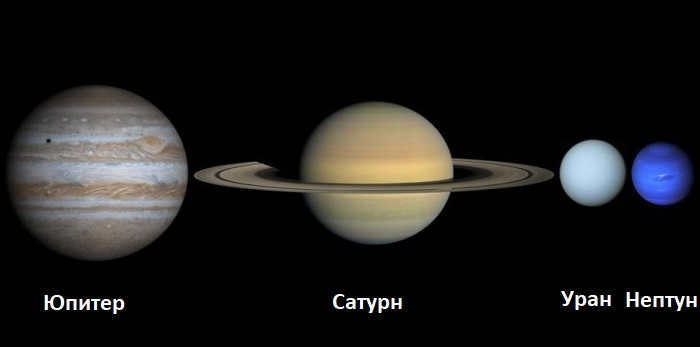
- At lower altitudes, the atmosphere smoothly transitions into a liquid state as a result of the increase in pressure;
- There is no distinct boundary between the “ocean” and the atmosphere;
- They possess a solid core;
- They possess satellites that are larger than certain dwarf planets;
- They have rings, with Saturn having the most prominent ones.
Due to the lack of a definite boundary between the gaseous and liquid states, it is not feasible to successfully land on gas giants. These celestial bodies are situated at greater distances from the Sun compared to the Earth group.
Within this group, there is a distinct subclass known as ice giants, which encompasses Uranus and Neptune. While Jupiter and Saturn primarily consist of hydrogen and helium, the seventh and eighth planets are predominantly composed of icy elements.
In 2006, scientists coined the term “dwarf planet” after discovering celestial bodies larger than Pluto. Previously, Pluto was classified as a planet and was compared in size to Mars. However, in the early 2000s, scientists found other space objects near Pluto that were almost the same size. For example, Erida is larger than Pluto.
This discovery led to the need for a new classification for these objects. In addition to Pluto, the group of dwarf planets includes:
There are several other celestial bodies beyond the orbit of Neptune that are vying for the status of a dwarf planet. All of them, except for Ceres, are located in the Kuiper belt, which is a cloud of asteroids. There is also a main asteroid belt located between Mars and Jupiter, and Ceres is located in that belt.
Dwarf planets are distinct from the Earth group and gas giants in that their small mass prevents them from clearing a path on their own. Instead, they intersect their orbits in regions where other celestial bodies congregate. Due to their lack of a gravitational field, dwarf planets constantly have small objects in their orbit.
Thanks to advancements in technology, scientists have been able to identify several additional contenders for the classification of dwarf planets. However, astronomers currently lack the necessary data. Dwarf planets remain poorly researched, and all measurements are approximations. One common feature among them is the presence of an icy layer on their surface. Ceres is the most extensively studied dwarf planet, as the other “dwarfs” are situated too far from Earth.
Is there a ninth planet?
Following the reclassification of Pluto, it was believed that there were 8 planets in the solar system. However, a peculiar phenomenon has been observed beyond the orbit of Neptune by scientists. They have observed new celestial bodies with their own orbits. The movements of these enigmatic objects, including asteroids and comets, could potentially be influenced by a planet that is several times larger than Neptune.
There is another theory, which is supported by the majority of scientists, suggesting that the ninth planet is actually a cluster of asteroids, comets, and other celestial objects. According to the latest data, astronomers have not yet discovered any unusual celestial bodies beyond the orbit of Neptune, and the sizes of the observed objects are too small to be classified as planets.
Officially, the existence of the ninth planet is considered to be non-existent. However, there are individuals who hold the belief that astronomers lack sufficient data to validate its existence.
Small Planets
These cosmic entities are distinguished by their diminutive size and their considerable distance from the Sun. This category of objects remains relatively unexplored due to their remote location. Nevertheless, with the advancement of technology, scientists are gathering increasingly significant data that contributes to the exploration of outer space.
Pluto
Pluto, which was classified as a “dwarf” planet in 2006, is one of the smallest planets in our solar system. It takes 248 years for Pluto to complete one orbit around its host star, and it rotates on its axis every 6.5 days. Situated in the Kuiper belt, Pluto is an intriguing celestial body worth exploring.
Jupiter, on the other hand, is the largest planet in our solar system and belongs to the gas giants. This massive planet has captivated the attention of astronomers, with spacecraft regularly venturing towards it to gather valuable data that is then transmitted back to Earth. For anyone with an interest in the wonders of the night sky, delving deeper into the mysteries of Jupiter is a must.
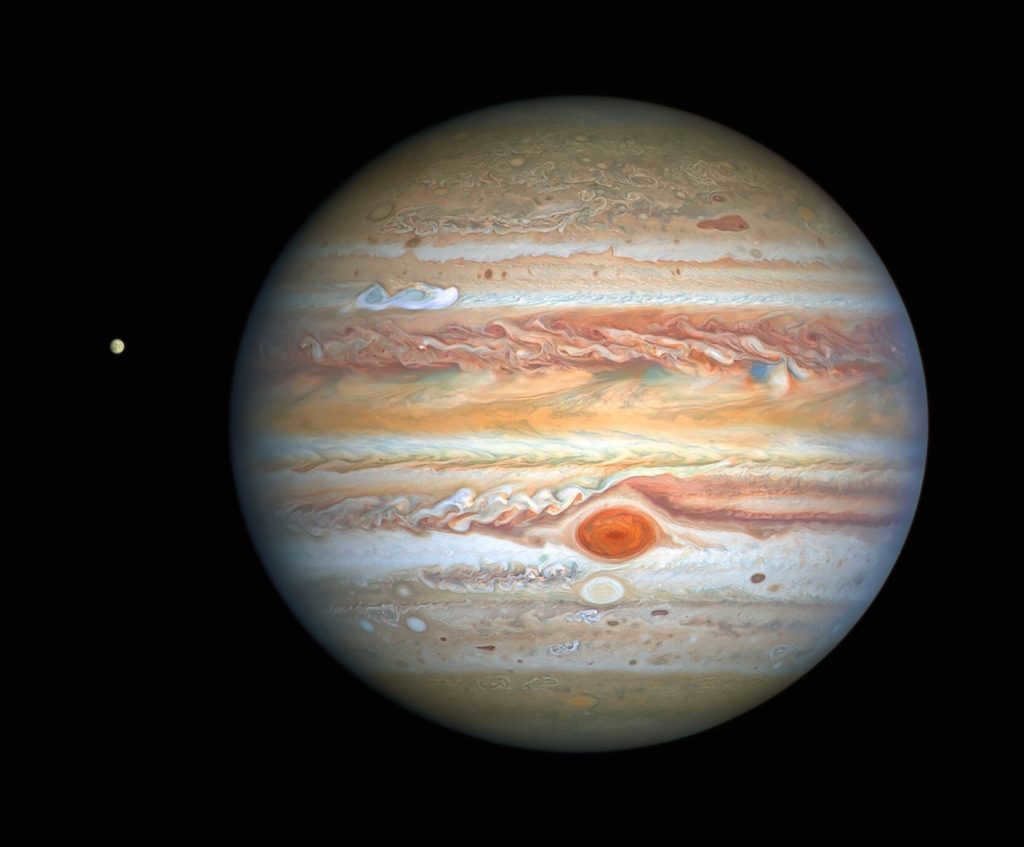
Essential details regarding Jupiter
Jupiter, the fifth planet in our solar system, is currently known to have 79 satellites. This celestial object is comprised of a central core, multiple layers, and a dense atmosphere. Its magnetic field is reminiscent of a flat disk. Interestingly, Jupiter possesses rings, although they are only visible when observed closely.
This planet is easily visible in the night sky, shining brightly due to its surface’s exceptional ability to reflect sunlight. The relatively low density of Jupiter suggests that the majority of its mass is composed of gases. However, the specific composition of its core remains a subject of ongoing research and investigation.
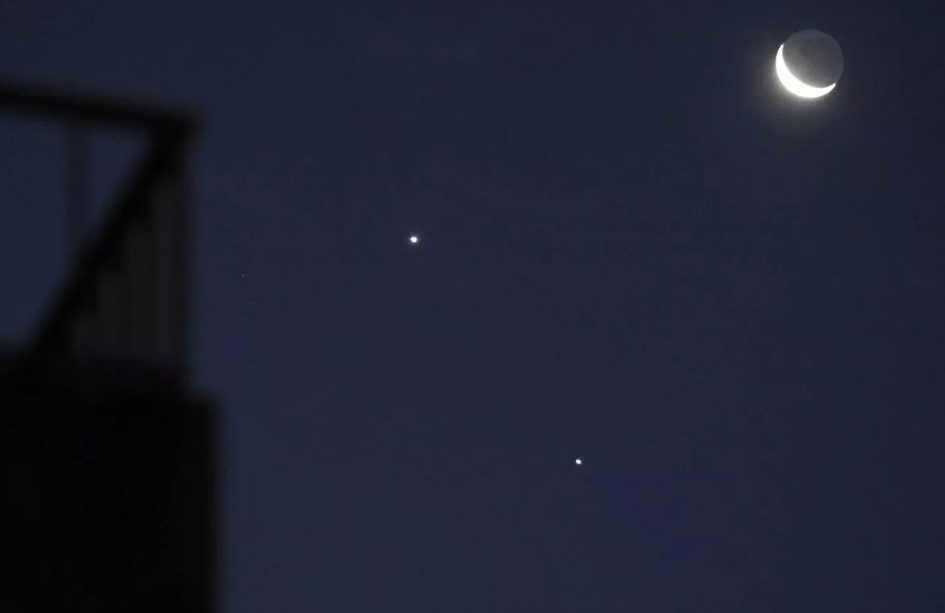
When it comes to structure, Jupiter and Earth couldn’t be more different. Jupiter, the fifth planet from the Sun, is classified as a gas giant due to its low density and massive volume.
The Naming
The planet gets its name from the Roman god Jupiter, who was the god of the sky, daylight, thunderstorms, and the father of all gods.
The Formation of Jupiter
Jupiter originated from the identical nebula as the Sun, as evidenced by its composition, which closely resembles that of our star. The proportion of hydrogen and helium in Jupiter is nearly identical to that of the Sun. However, Jupiter’s mass is approximately 1000 times smaller than that of the Sun, which is insufficient to initiate the thermonuclear reactions responsible for generating light and heat.
Dimensions
Jupiter has a radius of approximately 70,000 kilometers and a diameter of about 139.8 thousand kilometers. The reason for its considerable size is attributed to its formation in close proximity to the Sun, which led to the accumulation of significant amounts of gaseous matter around the central star.
Jupiter’s mass is more than double the combined mass of all other celestial bodies in the solar system (excluding the Sun), including comets and asteroids. The surface area of Jupiter exceeds 62 billion square kilometers.
The solar system is estimated to be about 4.6 billion years old. By utilizing isotope analysis techniques, scientists have been able to determine the age of the planet. Jupiter’s core, on the other hand, formed approximately one million years after the Sun’s formation.
The planet’s coloration
Photographs reveal Jupiter’s ever-changing appearance, with white, red, brown, orange, and yellow spots and stripes adorning its surface. The planet’s coloration is in a constant state of flux due to the formation of atmospheric vortices and rapidly changing weather conditions.
During storms, various substances such as sulfur, hydrocarbon, and phosphorus undergo transfer, resulting in the creation of multicolored spots. These spots provide valuable insights into the atmospheric phenomena occurring on the planet.
Composition of Jupiter’s Atmosphere
Jupiter’s atmosphere is made up of various layers, each with its own unique characteristics.
Troposphere
The troposphere, which extends approximately 50 kilometers in thickness, is a complex region filled with different gases. Notably, water vapor, ammonium hydrosulfite, and ammonia create distinct white and red lines within this layer. The white areas indicate the upward movement of gas, while the red areas signify the downward movement. These regions are often distinguished by the presence of wind currents. At higher altitudes within the troposphere, temperatures can plummet to as low as -160° Celsius.
Stratosphere
The stratosphere has a thickness of approximately 320 km. It is composed of a hydrocarbon haze. The temperature within the stratosphere can drop as low as -100° Celsius. The stratosphere is heated by both the sun’s radiation and the Earth’s internal heat. As the temperature increases, the speed at which the atmospheric layer moves also increases.


Thermosphere and exosphere
The thermosphere can reach temperatures as high as 725 °C. This causes a faint glow, preventing the planet from being completely dark at night. The heat source for this phenomenon is the Sun and particles from the magnetosphere.
Polar lights are observed at the north and south poles, and their intensity is much stronger compared to Earth. They are created by the planet’s magnetic field, intense radiation, and volcanic emissions from the moon Io.
In the exosphere, gas molecules gradually escape into outer space. There are no distinct boundaries for this part of the atmosphere.
Essentially, the colossal giant’s atmosphere is primarily composed of hydrogen and helium. There are also small amounts of methane, ammonia, sulfur, and water vapor present.
Magnetic Fields
Due to the immense pressure within Jupiter, hydrogen exists in a liquid state. Electrons serve as excellent conductors of electricity, and the planet’s rapid rotation further generates an exceptionally robust magnetic field. This magnetic field attracts ionized particles from the solar wind and those produced by satellites. Some of these particles contribute to the formation of auroras, while others contribute to the formation of Jupiter’s radiation belts.
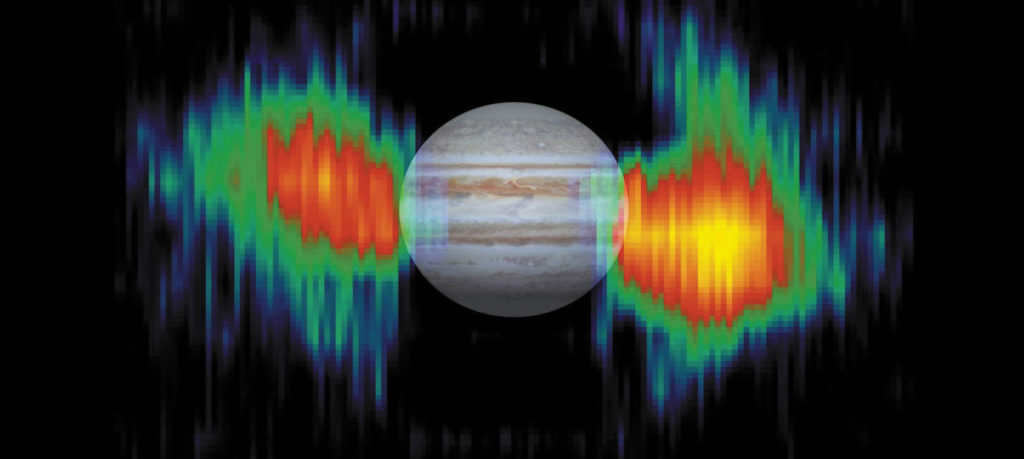
Jupiter’s radiation belts possess immense power. The electron flow within these belts poses a significant threat to spacecraft, as it has the potential to inflict severe damage upon their equipment.
Distinctive physical attributes of Jupiter
The planet’s primary physical characteristics include:
- polar compression – 0.06487;
- equatorial radius – 71.492 thousand kilometers;
- mean radius – 69.911 thousand kilometers;
- surface area – 62.2 billion km2 ;
- volume – 1430 trillion km 3 ;
- mass – 1.89∙10 24 tons;
- density – 1.33 g/cm;
- gravitational acceleration (at the equator) – 24.8 m/s 2 ;
- escape velocity – 59.5 kilometers per second;
- equatorial rotational velocity – 45300 km/h
- The duration of a day on Jupiter is 9 hours and 55 minutes.
- The inclination of Jupiter’s rotation axis relative to the ecliptic plane is -3.1 degrees.
- Jupiter’s year lasts for 12 years.
Did you know that Jupiter has rings? They were difficult to detect for a long time because they are quite thin. The rings of Jupiter include the inner ring, the main ring, and the outer rings.
The Temperature of Jupiter
Jupiter, the largest planet in our solar system, has a complex and varied temperature profile. Each layer of the planet has a different air temperature, making it a fascinating subject of study for scientists. However, due to the intense radiation levels on Jupiter, accurately measuring the temperature of specific areas is challenging and often requires assumptions and estimations.
The core of Jupiter is the hottest part of the planet, with temperatures reaching up to six times hotter than the Earth. Surrounding the core is a layer of metallic hydrogen, which exists in this state due to the extreme pressure at the center of the planet. Unfortunately, this region remains largely inaccessible to astronomers, making it difficult to obtain precise temperature measurements.
Estimations suggest that the temperature of the shell surrounding the core ranges from 6,000 to 21,000 degrees. This range is based on the assumption that high temperatures are required for the transition of solid hydrogen to liquid hydrogen. However, it is important to note that under the extreme pressure conditions on Jupiter, metallic hydrogen can also exist in a liquid state at lower temperatures.
The temperature on Jupiter is below freezing and can drop as low as -170°C. However, in the lower layers of the atmosphere, it can be slightly higher by around 20 to 25°. As you move up into the stratosphere, the temperature starts to increase significantly, and at an altitude of 1000 km, it can reach a scorching 600°C.
Exploring Jupiter’s Weather
Jupiter’s weather is nothing short of extreme. The planet is constantly experiencing powerful storms and hurricanes. The wind speeds on Jupiter can reach an astonishing 600 km/h. Moreover, whirlwinds can suddenly appear at any given point on the planet. These storms also have a remarkable ability to rapidly change their position within just a few hours.
Additionally, a large portion of Jupiter’s surface is covered with clouds that come in various shades of white and brown. These clouds form long streaks with well-defined boundaries. Each of these cloud formations moves at different speeds, creating what is known as “tropical regions.” The clouds are formed due to the chaotic air currents blowing at different altitudes.
There are also regions where the airflow descends. These regions are shaded in dark brown and are referred to as belts. The lighter regions are known as zones. The variation in color is a result of the unique gas composition.
Composition and Structure of the Surface
Jupiter primarily consists of a combination of gaseous and liquid substances. The composition and structure of Jupiter align with the characteristics commonly found in gas giants.
The atmosphere forms the outer layer of the planet. Within the planet, there is hydrogen, a nucleus, and various other chemicals. The core, which was only discovered in the late 1990s, appears to be a combination of solid metallic hydrogen and helium. Before this discovery, astronomers had a different hypothesis about the planet’s internal structure, suggesting that there were processes of radioactive decay occurring in the interior. It is estimated that the core could be 12 to 45 times more massive than Earth and account for 4 to 14% of the planet’s total mass.

As we move closer to the core of Jupiter, both the pressure and temperature increase significantly. In fact, at the very core of the planet, the temperature can reach a scorching 35,700 degrees Celsius. Additionally, the pressure at the center of Jupiter is an incredible 4,500 GigaPascals.
Let’s now shift our focus to Jupiter’s orbit. Here are the key orbital characteristics of this gas giant:
– At its closest point to the Sun (perihelion), Jupiter is approximately 740.5 million kilometers away.
– At its farthest point from the Sun (aphelion), Jupiter is about 816.5 million kilometers away.
– The major semi-major axis of Jupiter’s orbit is approximately 778.5 million kilometers.
– Jupiter’s orbit has an eccentricity of 0.0487, indicating a slightly elongated shape.
– On average, Jupiter moves through its orbit at a velocity of 13 kilometers per second.
Due to its significantly shorter rotation period compared to other planets in the solar system, Jupiter experiences a “Jupiterian” year every 10475 Earth days. Jupiter’s orbit is more elongated than that of Earth, resulting in significant variations in its distance from the Sun.
The Fascinating Great Red Spot
The Great Red Spot is a captivating feature of Jupiter. It is a powerful anticyclone, with its distinctive dark red color resulting from sulfur and ammonia particles originating from deep within the planet’s atmosphere. These particles darken and lighten upon exposure to the Sun’s rays.
The permanence of this spot is currently unknown. However, astronomers first discovered it in the 1600s, and while it is shrinking in size, it shows no signs of disappearing completely. It is projected to become nearly circular within the next 20 years, and there is a possibility that it may eventually vanish altogether.
The red spot can be found in the upper atmosphere and is characterized by its high speed of rotation, reaching approximately 360 kilometers per hour. This massive storm has dimensions of 12,000 km x 24,000 km and extends about 8 km above the surrounding clouds.
Jupiter’s Satellites
As of 2019, a total of 79 satellites have been identified in orbit around Jupiter. Among these, 4 have been named the “Galilean” satellites due to their discovery by Galileo Galilei. These satellites, namely Io, Europa, Ganymede, and Callisto, played a crucial role in confirming the heliocentric system, which led to Galileo’s persecution by the Catholic Church.

Ganymede
Ganymede, the largest moon of Jupiter, has a radius of 2,634 kilometers and a surface area of 87 million square kilometers. It is approximately 40 times less massive than Earth and has a gravitational force on its surface that is almost 7 times weaker than Earth’s. Ganymede orbits Jupiter at an average distance of 1,070,000 kilometers, making it the third most distant moon. Interestingly, Ganymede’s mass is about 45% that of Mercury. It takes approximately one week for Ganymede to complete one orbit around Jupiter.
Ganymede, which was first observed by Galileo in 1610, received its name from the legendary figure Ganymede, the son of the Trojan king Tros. According to the myth, Ganymede was abducted by Zeus in the form of an eagle and later became the cupbearer of the gods on Mount Olympus. As a reward for his service, Ganymede was granted everlasting youth and immortality.
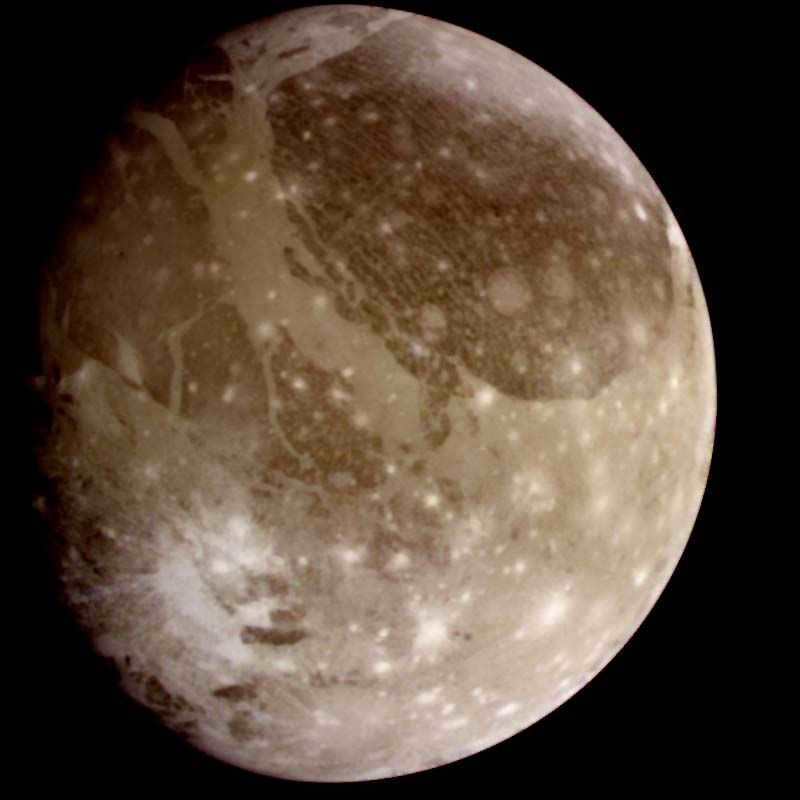
This moon likely formed from a disk of material or a cloud of gas and dust. It orbited around Jupiter for a period of time after the planet’s formation. The moon formed closer to Jupiter, where the gas and dust cloud was denser.
Ganymede is composed of a combination of rock and frozen water. The ice may also contain ammonia. The specific composition of the solid rock is still unknown. Spectral analysis has identified several substances present on Ganymede:
- carbon dioxide;
- sulfur dioxide;
- dicyane;
- sulfuric acid;
- organic compounds;
- magnesium and sodium sulfate.
The satellite is believed to have a central core made of iron, surrounded by a layer of ice and a mantle of silicate. The estimated radius of the core is between 700 and 900 km, while the outer ice layer ranges from 800 to 1000 km. The remaining portion is made up of the silicate mantle. The surface of the satellite features craters, grooved areas, and polar caps.
Scientific studies have revealed the existence of a thin atmosphere and an exosphere composed of oxygen on Ganymede. The presence of an ionosphere on the satellite is still a subject of debate among researchers. However, the Galileo spacecraft confirmed the presence of a magnetic field on Ganymede, making it the only moon in the solar system with a magnetosphere. If it weren’t for the intense radiation, Ganymede would be a promising candidate for terraforming.
Callisto
Callisto is the second largest moon of Jupiter, the farthest from the planet, and the third largest moon in the entire solar system. It is named after Zeus’ mistress, a character from Greek mythology.
Callisto’s rotation period is the same as its orbital period around Jupiter, resulting in one side always facing the planet. With a radius of 2410 km, it is almost the same size as Mercury. The surface area of Callisto is 73 million km2. It has a mass of approximately 1020 tons and a volume of 59 billion km3. Callisto’s gravitational force is 8 times weaker than that of Earth, and it has no axial tilt.
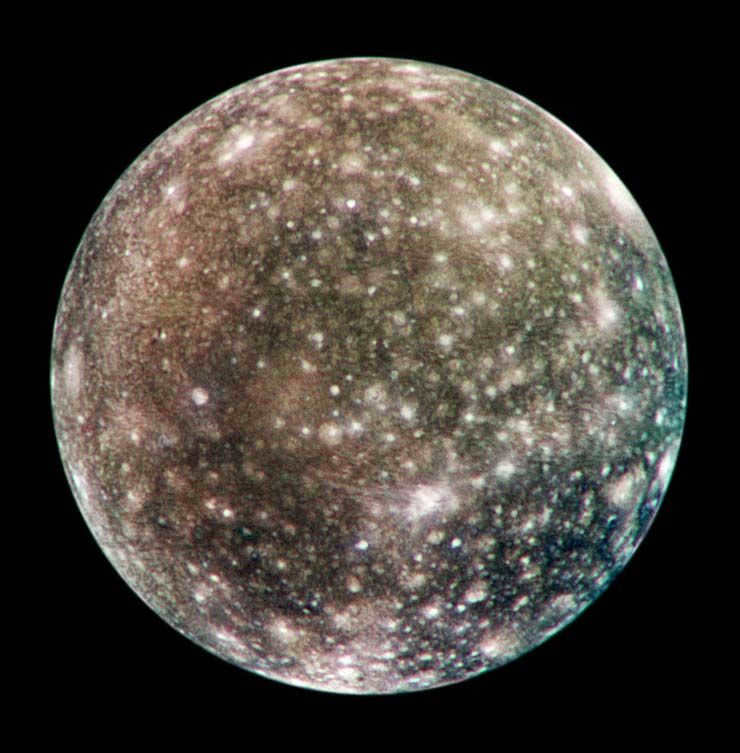
Based on spectroscopy data, scientists have discovered ice, carbon dioxide, silicon compounds, and organic matter on the surface of Callisto. The terrain is intricate, featuring craters and circular structures. Additionally, there is a thin atmosphere of carbon dioxide and an ionosphere surrounding the satellite.
It is believed that Callisto formed through the accretion of dust and gas, resulting in a subsurface ocean of liquid water approximately 100 kilometers deep. There is a possibility that extraterrestrial life exists on Callisto. This moon could serve as a suitable base for mankind to study the giant planets, as it is located outside the radiation belts.
It’s fascinating to note that the number of moons orbiting Jupiter can change. Some comets that are attracted to the planet can temporarily become its moons.
Europa
Europa, which was discovered in 1610, is the smallest of the Galilean satellites. It has a radius of approximately 1560 km and a surface area exceeding 30 million km2 . The satellite’s volume measures around 16 billion km3 . The equatorial region experiences a free-fall acceleration of about 1.3 m/s2 . Similar to Callisto, Europa is tidally locked to Jupiter, with one side always facing the planet. Its average distance from Jupiter is roughly 665,000 km.
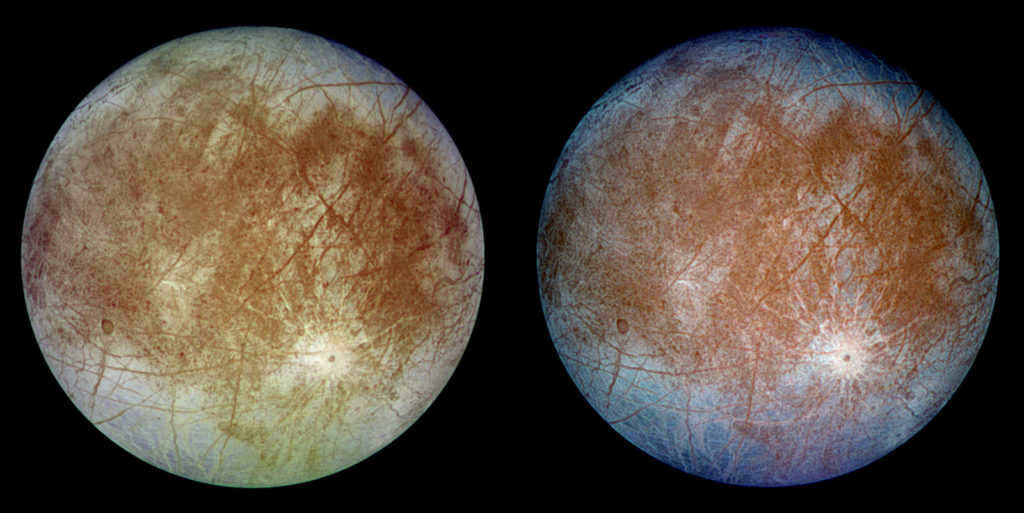
There might exist an ocean beneath the satellite’s surface. Many astronomers hold the belief that the body of water could have been formed due to the heat produced by the tides. The theory of radioactive decay as a heat source does not hold up to scrutiny, as the amount of heat generated by it is clearly insufficient.
Spectrographic observations have discovered the presence of a scarce atmosphere composed of oxygen molecules on Europa. The oxygen is sourced from the decomposition of water molecules into hydrogen and oxygen atoms under the influence of solar and radiation. Due to low gravity, hydrogen quickly escapes into outer space. The atmospheric pressure on Europa amounts to no more than one millionth of a pascal.
Europa, a moon of Jupiter, is considered a potential hotspot for extraterrestrial life within our solar system. Scientists believe that life may exist in the vast ocean hidden beneath Europa’s icy crust. However, despite extensive research and exploration, no definitive signs of life have been detected on this intriguing satellite.
One of the major challenges of exploring Europa is its proximity to Jupiter’s powerful radiation belts. These belts emit high levels of radiation, making it extremely hazardous for astronauts to venture onto Europa’s surface. In fact, an astronaut exposed to the radiation on Europa would receive a lethal dose within a matter of hours.
Io
Io is the satellite closest to Jupiter, with an average distance from the planet of approximately 420,000 kilometers. It has a mass of about 9∙10 19 tons and a volume of around 25 billion km3. The surface gravity on Io is approximately 1.8 m/s 2 . Similar to Callisto and Europa, Io is tidally locked to Jupiter, always showing the same face. Its orbital period around the planet is approximately 1.75 days. The satellite was named after the mythological character Io, who was a priestess of Hera. With a diameter of 3,642 km, Io is the fourth-largest satellite in the Solar System.
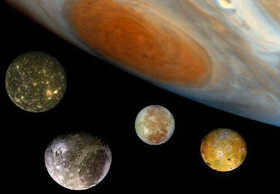

Jupiter boasts a considerable number of moons – a total of 79 (as of 2018). Among them, the largest ones are Io, Europa, Ganymede, and Callisto. Furthermore, Jupiter is adorned with rings encircling the planet in a perpendicular direction to its equator, located at a distance of 55 thousand kilometers from the atmosphere. These rings have a diameter of 250 thousand kilometers.
While the existence of Saturn’s rings has been known since 1655, the discovery of Jupiter’s rings came much later in March 1979 when the Voyager-1 and Voyager-2 spacecraft were studying the planet. Images taken by these spacecraft revealed the presence of rings around Jupiter. Unlike Saturn’s prominent and wide rings, Jupiter’s rings are much thinner and are located approximately 55,000 kilometers above the planet’s surface, just above the upper clouds. Composed primarily of ice and small rocky objects, Jupiter’s rings are difficult to see due to their extremely low reflectivity of sunlight. The ring system is made up of three components: the first being a bright and round ring, followed by a second component that thins out towards the edges, and finally a broad halo that surrounds the plane of the other two rings both above and below.
The prominent moons of Jupiter
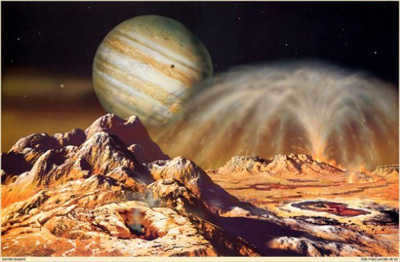
Io, which has a radius of 1815 km, is known for being the satellite closest to Jupiter, with a distance of 422 thousand km. It takes only 42.5 hours for Io to complete one orbit around Jupiter, which is shorter than a lunar month. This satellite boasts a spectacular mountainous landscape, with active volcanoes that continuously erupt and spew molten lava. One of these eruptions was captured by the Galileo spacecraft during its study of Io.
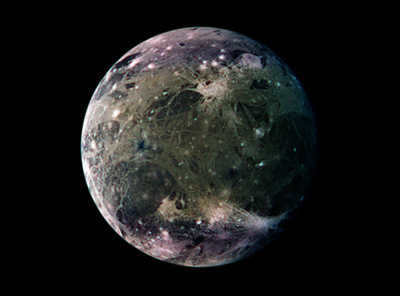
Ganymede, measuring 2631 kilometers in radius, holds the distinction of being the largest moon among all the planets in our solar system. Although its diameter is smaller than that of Saturn’s Titan and Neptune’s Triton, Ganymede’s surface is notable for its thick layer of ice, estimated to be over 100 kilometers deep. Scientists have put forth the theory that beneath this icy covering, there may exist water mixed with mud.
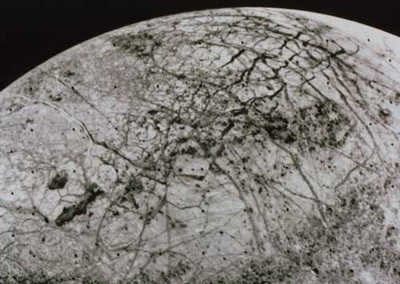
Europa, the moon of Jupiter, is the newest among Jupiter’s satellites, being only 100 million years old. It has a radius of 1569 kilometers. When observing Europa through the images captured by the interplanetary spacecraft “Galileo,” it appears like a perfect sphere, resembling a billiard ball. The moon is covered with a thick layer of ice, and the presence of fractures and cracks similar to icebergs has led scientists to speculate the existence of a mysterious underwater ocean beneath the ice.
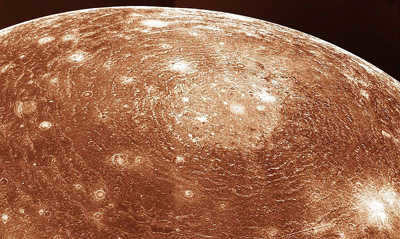
Lastly, Callisto, the farthest celestial body from Jupiter, is located approximately 1.88 million kilometers away and boasts a radius spanning 2,400 kilometers. This celestial object holds the distinction of being the most ancient in the entire Solar System. This is evident from the multitude of craters scattered across its surface, as well as the unchanged landscape that has persisted for billions of years.
Structure and Appearance
Regarding the composition and appearance of the satellites, the current knowledge is as follows:
- The satellite Io, or more specifically its surface, is marked by extensive streams of volcanic emissions and experiences significant heating during volcanic eruptions.
- Europa is enveloped by a layer of ice, which exhibits noticeable chipping in certain areas, revealing individual blocks of ice. This suggests the presence of a liquid ocean underneath the icy surface, with relatively higher temperatures.
- The satellite Ganymede bears a striking resemblance to the Moon, showcasing a grid-like pattern of intersecting lines on its surface. It also boasts numerous craters surrounded by smooth terrain.
- Callisto, akin to Europa, is covered by an icy layer and features multiple craters, as well as ring-shaped anomalies.
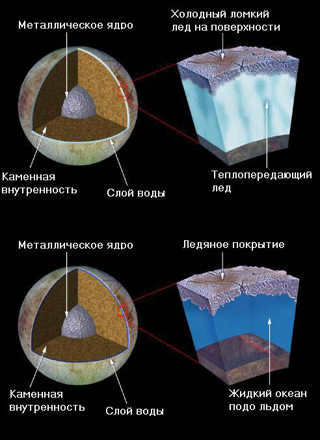

Fascinating information and examination of Jupiter’s moons
- The moon Ganymede stands out for its impressive size, surpassing even the diameter of the planet Mercury.
- Scientists have provided evidence of a vast ocean beneath Europa’s surface, while the moon Io is known for its intense volcanic activity, with lava consisting of basaltic sulfuric materials.
- Callisto holds the title for the most heavily cratered celestial body, but due to its age, estimated to be around 4 billion years old, its geological activity is extremely low.
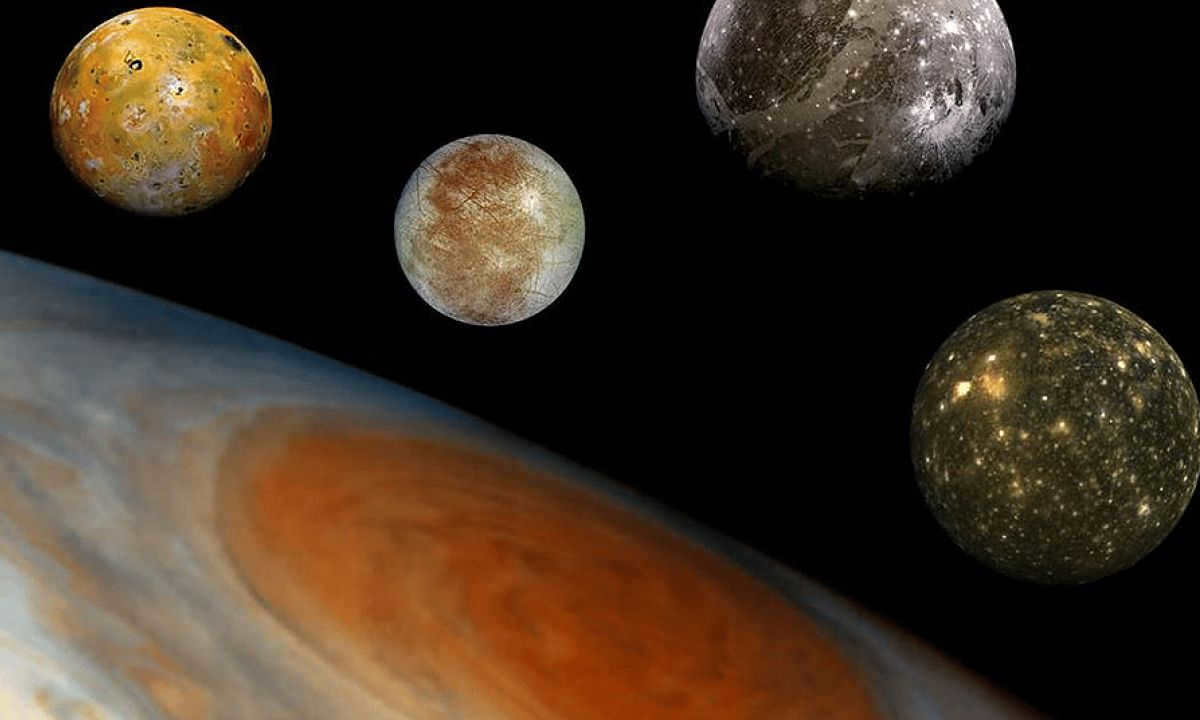
Jupiter, the largest planet in the solar system, is a member of the gas planet group. It is a massive planet with a significant number of discovered satellites. The question that often arises is how many satellites does Jupiter have. Jupiter boasts a substantial amount of satellites, and their formation process is quite remarkable.
In this article, we will delve into the topic of Jupiter’s satellites, discussing their quantity, formation, as well as some intriguing characteristics and facts.
What is the number of satellites orbiting Jupiter?
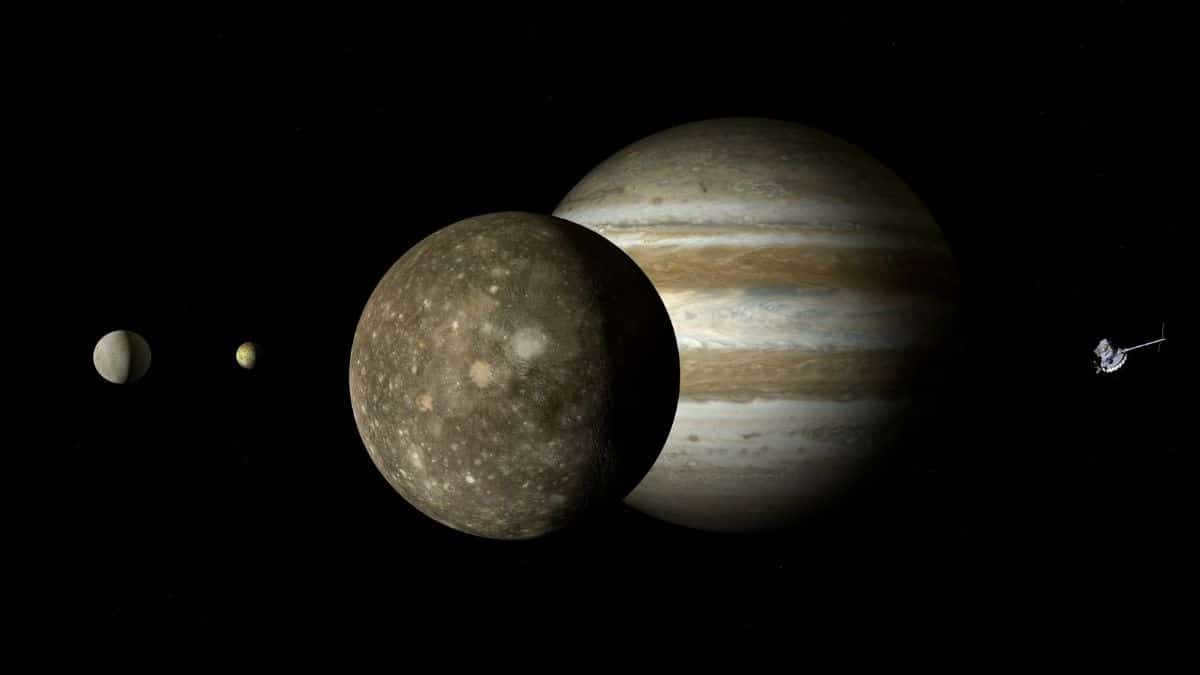
According to recent research findings, it has been established that in 2020, Jupiter had a collective count of 79 moons or natural satellites. It is anticipated that this figure will rise by 2021 due to the discovery of additional moons in the post-2020 era. If you are interested in finding out the number of satellites that Jupiter has had since 600, you can refer to the study conducted by Edward Ashton and his colleagues, titled “1 XNUMX-kilometer irregularly shaped retrograde satellites of Jupiter.”
Out of all the moons that orbit Jupiter, the most notable ones are the Galilean satellites. These four spherical moons were first discovered by Galileo Galilei in the year 4, and they were considered to be some of the largest moons in the entire solar system. Initially, Galileo named them Jupiter 1, Jupiter 2, Jupiter 3, and Jupiter 4 based on their distance from the planet (from inner to outer). However, they are now known by the names proposed by Simon Marius: Io, Europa, Ganymede, and Callisto.
What sets these Galilean satellites apart is that they are proper satellites, meaning they were formed in orbit around Jupiter rather than being captured from elsewhere.
Io
Io, which is also known as Jupiter 1 by its discoverers, is one of the four satellites of Galileo. It is the third largest and closest to Jupiter, making it the innermost moon. Io is even larger than Earth’s moon, with a diameter of approximately 3,643 km. It orbits around Jupiter in just 1.77 days, at a distance of 421,800 XNUMX km. This moon possesses several unique characteristics:
- Firstly, it boasts over 400 active volcanoes on its surface, making it a hub of intense geologic activity. In fact, Io has the highest volcanic activity in the entire solar system. This is primarily due to tidal heating caused by the gravitational pull between Jupiter and its larger satellites. As a result, volcanic eruptions can shoot up to heights exceeding 500 kilometers, and there are no visible craters on Io’s surface.
- The influence of Jupiter’s magnetic field and the proximity of Io to the Galilean satellites Europa and Ganymede affect the orbit of Io.
- The composition of its atmosphere is primarily sulfur dioxide (SO2).
- Compared to other objects in the solar system, Io has a higher density.
- Lastly, Io contains fewer water molecules than the other satellites.
Europe
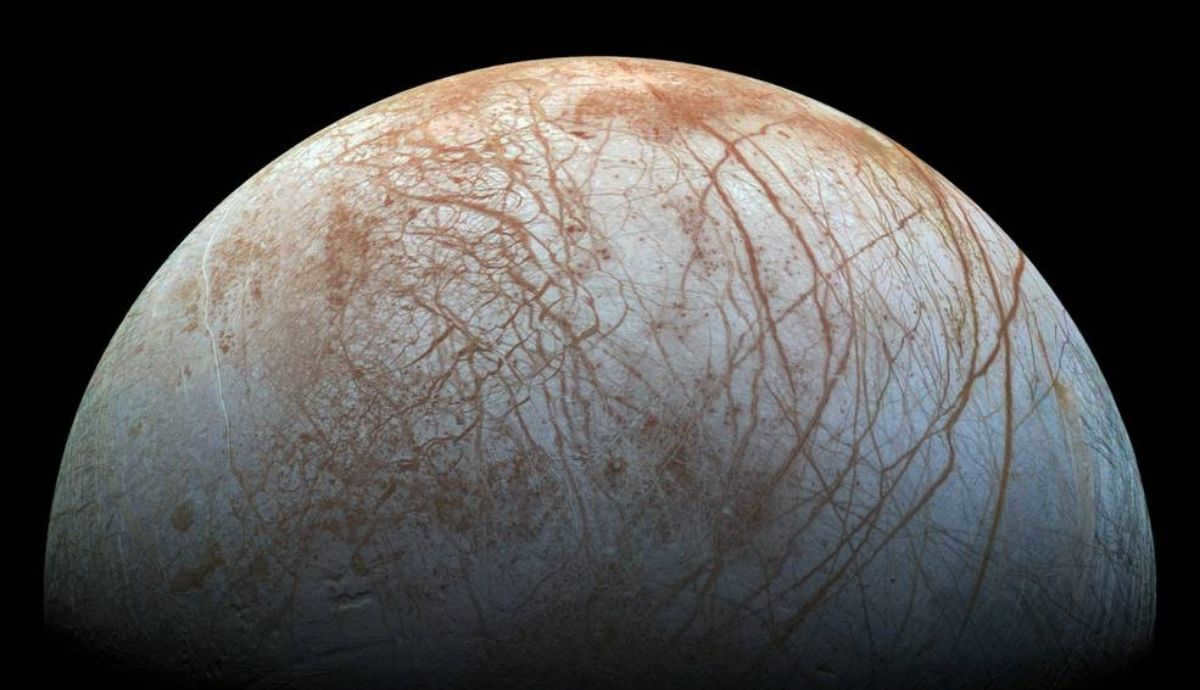
Europa, also known as Jupiter II, is the most fascinating of Jupiter’s satellites, despite being the smallest among the Galilean satellites with a diameter of 3.122 kilometers. But what makes it so captivating? It is of great interest to the scientific community due to its moon’s icy surface, which is believed to hide a massive ocean beneath that is 100 kilometers thick. This ocean is speculated to be shrinking due to the heat produced by atomic nuclei made up of nickel and iron, and there is a possibility that it could support life. In 2016, NASA confirmed this speculation, and although there is still no concrete scientific evidence, there is optimism that aquatic life may thrive on this moon.
Another significant aspect of Europa is its relatively short orbital period around Jupiter, which lasts 100 days. This moon has a radius of 671,100 3.5 kilometers, and its young surface geology is evident from a geological crash of over XNUMX meters. Additionally, it is worth mentioning that Europa’s atmosphere is composed of oxygen from abiotic sources, and water vapor is produced when light interacts with its frozen surface.
Ganymede
Named Ganymede or Jupiter 3 by Galileo, this is the largest satellite in Galileo’s collection. With a diameter of 1,070,400 kilometers, Ganymede surpasses Mercury, the planet closest to the Sun, in size. It completes a revolution around Jupiter, spanning a distance of 1,070,400 kilometers, in seven days.
Ganymede possesses several distinctive features that set it apart from other satellites, lending it a unique allure:
- One notable aspect is that this silicate ice moon harbors a liquid iron core and an internal ocean that scientists believe may contain more water than our own planet.
- Furthermore, it boasts its own magnetic field, unlike its counterparts, which is thought to be the result of convection within its liquid core.
- Not only is it the largest, but it is also the brightest of the Galilean moons.
Calisto
Callisto, also known as Jupiter IV, is a large satellite with a lower density compared to others. With a diameter of 4,821,882,700 km, it orbits Jupiter at a distance of 17,200,000 km and completes one revolution in 16.7 days. Being the outermost moon, it is less affected by Jupiter’s magnetic field.
From a geological perspective, Callisto is distinguished by its ancient surface and a tenuous atmosphere consisting of oxygen and carbon dioxide. Scientists believe that there might be an underground ocean of liquid water on Callisto.
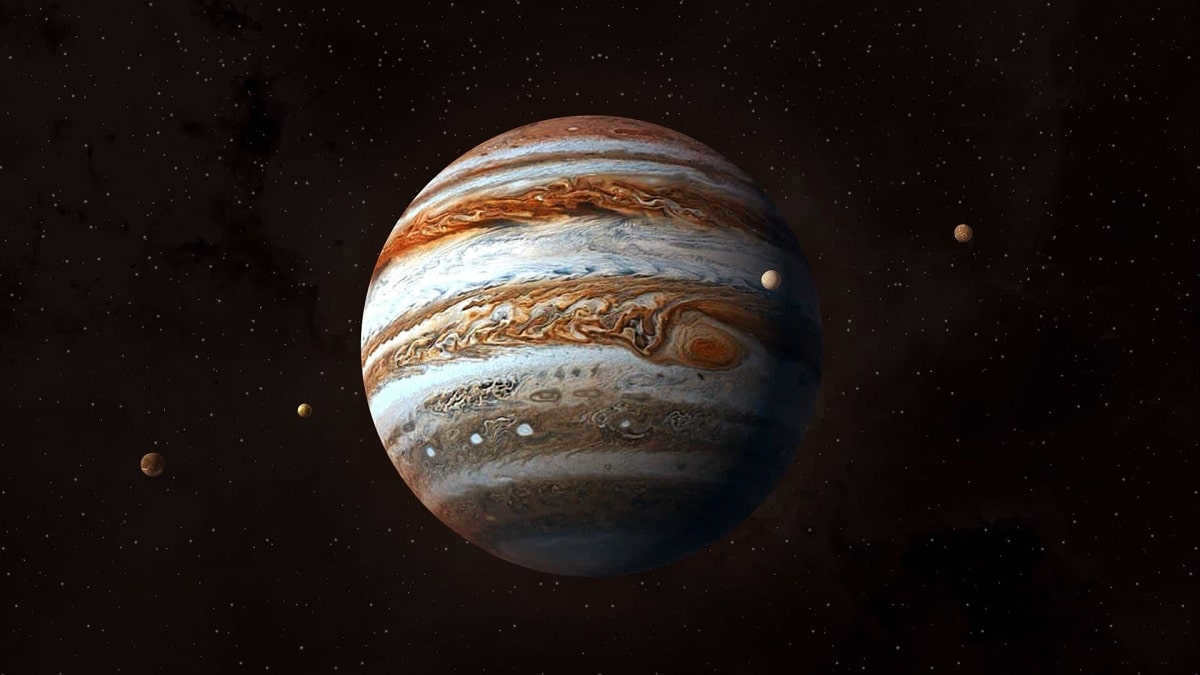
Jupiter has a total of 79 satellites, but only 8 are considered common. The 4 regular satellites named after Galileo are well-known, but there are also 4 other satellites known as the Amalthean satellites (Phoebe, Amalthea, Adrastea, and Metida). These Amalthean satellites share some similarities: they are the closest to Jupiter, orbit in the same direction, and have a low orbital inclination.
On the other hand, the irregular satellites have elliptical orbits and are located much farther from the planet. Some examples of Jupiter’s irregular satellites include the Himalayan group, Themisto, Carpo, and Valetudo.
As you can observe, we are already aware of the number of satellites that Jupiter possesses and the primary characteristics of each individual one. Due to its vast size, Jupiter has the capacity to accommodate a significant number of satellites. Numerous scientists hold the belief that these satellites have the potential for life to flourish. It is my hope that with this information, you will gain a better understanding of the quantity of satellites that Jupiter possesses and the key features associated with them.
The content provided in this article adheres to our editorial ethics guidelines. If you come across any errors, please click here to report them.
Full Article Summary: Network Meteorology " astronomy " How many satellites does Jupiter have?
Jupiter’s satellites are the natural satellites of Jupiter, which is the largest planet within our solar system. Presently, there are 67 known satellites of Jupiter that vary in size, ranging from one kilometer to over 5,000.
Jupiter possesses a lesser-known dust ring system that has yet to gain widespread recognition. Nonetheless, these rings lack the grandeur and prominence of Saturn’s renowned rings and remain undetectable through telescopes.
The satellites of Jupiter are typically categorized into two distinct groups: the internal satellites and the external satellites.
There are 8 internal satellites that revolve around Jupiter’s equator in circular orbits. These satellites can be divided into two subgroups.
The first subgroup, known as the Amalthea group, consists of the satellites Metida, Adrastea, and Amalthea. Teba is the farthest from Jupiter in this subgroup. These satellites orbit at a distance of 2-3 radii from Jupiter’s center. They are relatively small, with diameters ranging from 20 to 250 km.
The second subgroup is called the Galilean satellites, which are the largest satellites of Jupiter. Like the Amalthea group, they also orbit in circular orbits that are relatively close to Jupiter.
The group of satellites following the first group are known as the Outer Satellites of Jupiter. These satellites are generally small in size, measuring only a few kilometers across and rarely larger. Among these, the largest is Himalia, with a diameter of approximately 170 kilometers. The Outer Satellites of Jupiter orbit at a significant distance from the planet, following elliptical paths that are inclined at substantial angles to Jupiter’s equator. Interestingly, while the inner satellites orbit Jupiter in the same direction as the planet’s rotation, the outer satellites mostly move in the opposite direction. These retrograde orbits are characterized by their names, which always end with the letter “e,” regardless of the individual they are named after.
Due to their small size, Jupiter’s outer satellites can only be observed from Earth through powerful telescopes.
The exploration of Jupiter’s moons has been limited, except for the ones discovered by Galileo. Now, let’s take a quick look at their noteworthy features.
Galileo’s Discoveries: Jupiter’s Moons
The Galilean moons of Jupiter were first observed by Galileo Galilei in 1610 using one of the earliest telescopes. These four moons, Ganymede, Callisto, Io, and Europa, are the largest and most well-known of Jupiter’s moons and can be easily seen from Earth with small binoculars or a telescope.
Ganymede, with a diameter of 5262 kilometers, is the largest of Jupiter’s moons.
Callisto is slightly smaller, measuring at 4820 km.
Io and Europa are both over 3000 km in size.
The closest moon to them, Amalthea, is much smaller, with dimensions of only 250×146×128km due to its irregular shape. Because of this, it requires a more powerful instrument to observe the other moons. In fact, the 49 smaller moons of Jupiter have only been discovered within the past 20 years as more advanced telescopes have become available.
Ganymede: Jupiter’s Largest Satellite
Ganymede is not only the largest satellite of Jupiter, but it is also the largest among all the satellites in the entire solar system. With a diameter of 5262 km, it surpasses even our Moon and is slightly larger than the planet Mercury! To put it into perspective, the Moon has a diameter of 3474.2 km, while Mercury measures 4880 km. If Ganymede were to orbit the Sun instead of Jupiter, it would easily qualify as a fully-fledged planet. Despite being the heaviest moon in our solar system, Ganymede is still about half as dense as Mercury. It possesses a molten core, a magnetosphere, and even the beginnings of an atmosphere, complete with traces of oxygen. Beneath its thick layer of water ice, there is believed to be an ocean of water. In summary, if it weren’t for the intense radiation from Jupiter, Ganymede would be an incredibly intriguing destination for exploration.
Callisto
Callisto is slightly smaller than Ganymede, measuring 4,820.6 kilometers in diameter. Similar to Ganymede, it is covered by a thick layer of water ice, approximately 200km deep. However, unlike Ganymede, which possesses a molten liquid core, Callisto lacks geological activity. Its core is only weakly developed, and the presence of numerous craters and a layer of dust indicate the absence of tectonic processes. The gravity on Callisto’s surface is about 1/8th of Earth’s, which is not insignificant. Of particular importance for future settlers is the fact that Callisto is situated outside of Jupiter’s radiation belts!
Europe
Europa is the smallest of Jupiter’s Galilean satellites. It has a diameter of 3138 kilometers. At the core of the satellite, there is a metallic center. Similar to Ganymede and Callisto, Europa’s surface consists of water ice, beneath which lies a presumed salty water ocean.
Scientists are particularly interested in this subglacial ocean. The layer of ice above it is thin, measuring only 10 to 30 kilometers, which is insufficient to create high pressure. Hence, the water there must be in a liquid state due to positive temperatures, rather than high pressure like on the aforementioned satellites.
Where there is a favorable temperature and water, the possibility of life cannot be ruled out! Previously, it was believed that life could only arise within a narrow “life belt” around a central star. This is why Europa is one of the primary subjects for study by space agencies.
However, the presence of radiation throughout Europa’s location within Jupiter’s radiation belts complicates matters.
Io is Jupiter’s nearest Galilean satellite. With a diameter of 3,642 kilometers, it has a metallic core, a liquid mantle, and a crust ranging in thickness from 10 to 40 kilometers. One of Io’s most distinctive features is its intense volcanic activity, with approximately 400 volcanoes.
In 1973, NASA’s Pioneer 10 spacecraft conducted a study of Jupiter’s satellites, including measuring the density of the four Galilean satellites. In 1979, Voyagers 1 and 2 made significant discoveries, including finding volcanoes on Io and an icy layer on Europa. In 2007, the New Horizons spacecraft further refined our understanding of these satellites. From 1995 to 2003, the Galileo spacecraft entered Jupiter’s orbit and conducted detailed exploration of the satellites.
In the early 2020s, there are plans to launch a spacecraft to study Ganymede and Europa. One of the main objectives of this mission is to confirm the presence of a subglacial ocean on Europa and conduct further research on it.
Characteristics of Jupiter’s Satellites
| № | Name | Size (km) | Mass (kg) | Major semi-axis (km) | Orbital period (days) | Year of discovery |
| 1 | Metida | 60×40×34 | ~3.6×10^16 | 127,690 | +7h 4m 29s | 1980 |
| 2 | Adrastea | 20×16×14 | ~2×10^15 | 128,690 | +7h 9m 30s | 1979 |
| 3 | Amalthea | 250×146×128 | ~2.08×10^18 | 181,366 | +11h 57m 23s | 1892 |
| 4 | Thebes | 116×98×84 | ~4.3×10^17 | 221,889 | +16h 11m 17s | 1980 |
| 5 | Io | 3642 | 8.9×10^22 | 421,700 | +1.77 | 1610 |
| 6 | Europa | 3122 | 4.8×10^22 | 671,034 | +3.55 | 1610 |
| 7 | Ganymede | 5260 | 1.5×10^23 | 1,070,412 | +7.15 | 1610 |
| 8 | Callisto | 4820 | 1.1×10^23 | 1,882,709 | +16.69 | 1610 |
| 9 | Themisto | 8 | 6.9×10^14 | 7,393,216 | +129.87 | 1975/2000 |
| 10 | Leda | 10 | 1.1×10^16 | 11,187,781 | +241.75 | 1974 |
| 11 | Himalia | 170 | 6.7×10^18 | 11,451,971 | +250.37 | 1904 |
| 12 | Lysithea | 36 | 6.3×10^16 | 11,740,560 | +259.89 | 1938 |
| 13 | Elara | 86 | 8.7×10^17 | 11,778,034 | +261.14 | 1905 |
| 14 | Dia | 4 | 9.0×10^13 | 12,570,424 | +287.93 | 2000/2012 |
| 15 | Carpo | 3 | 4.5×10^13 | 17,144,873 | +458.62 | 2003 |
| 16 | S/2003 J 12 | 1 | 1.5×10^12 | 17,739,539 | −482.69 | 2003 |
| 17 | Euporie | 2 | 1.5×10^13 | 19,088,434 | −538.78 | 2002 |
| 18 | S/2003 J 3 | 2 | 1.5×10^13 | 19,621,780 | −561.52 | 2003 |
| 19 | S/2003 J 18 | 2 | 1.5×10^13 | 19,812,577 | −569.73 | 2003 |
| 20 | S/2011 J 1 | 1 | ? | 20,101,000 | −580.7 | 2011 |
| 21 | S/2010 J 2 | 1 | 20,307,150 | −588.82 | 2010 | |
| 22 | Telxine | 2 | 1.5×10^13 | 20,453,753 | −597.61 | 2004 |
| 23 | Evante | 3 | 4.5×10^13 | 20,464,854 | −598.09 | 2002 |
| 24 | Helike | 4 | 9.0×10^13 | 20,540,266 | −601.40 | 2003 |
| 25 | Orthosie | 2 | 1.5×10^13 | 20,567,971 | −602.62 | 2002 |
| 26 | Jocaste | 5 | 1.9×10^14 | 20,722,566 | −609.43 | 2001 |
| 27 | S/2003 J 16 | 2 | 1.5×10^13 | 20,743,779 | −610.36 | 2003 |
| 28 | Praxidike | 7 | 4.3×10^14 | 20,823,948 | −613.90 | 2001 |
| 29 | Harpalike | 4 | 1.2×10^14 | 21,063,814 | −624.54 | 2001 |
| 30 | Mneme | 2 | 1.5×10^13 | 21,129,786 | −627.48 | 2003 |
| 31 | Hermippe | 4 | 9.0×10^13 | 21,182,086 | −629.81 | 2002 |
| 32 | Tione | 4 | 9.0×10^13 | 21,405,570 | −639.80 | 2002 |
| 33 | Ananke | 28 | 3.0×10^16 | 21,454,952 | −642.02 | 1951 |
| 34 | Herse | 2 | 1.5×10^13 | 22,134,306 | −672.75 | 2003 |
| 35 | Etne | 3 | 4.5×10^13 | 22,285,161 | −679.64 | 2002 |
| 36 | Calais | 2 | 1.5×10^13 | 22,409,207 | −685.32 | 2002 |
| 37 | Taigete | 5 | 1.6×10^14 | 22,438,648 | −686.67 | 2001 |
| 38 | S/2003 J 19 | 2 | 1.5×10^13 | 22,709,061 | −699.12 | 2003 |
| 39 | Haldene | 4 | 7.5×10^13 | 22,713,444 | −699.33 | 2001 |
| 40 | S/2003 J 15 | 2 | 1.5×10^13 | 22,720,999 | −699.68 | 2003 |
| 41 | S/2003 J 10 | 2 | 1.5×10^13 | 22,730,813 | −700.13 | 2003 |
| 42 | S/2003 J 23 | 2 | 1.5×10^13 | 22,739,654 | −700.54 | 2004 |
| 43 | Erinome | 3 | 4.5×10^13 | 22,986,266 | −711.96 | 2001 |
| 44 | Aoide | 4 | 9. |





